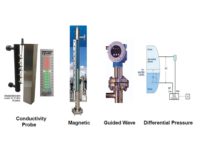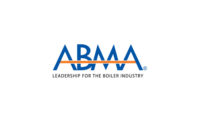Prior to 1991, for operating pressures up to 400 psi, the Code required two water gage glasses or one water gage glass combined with a set of three gage cocks (also known as try cocks, and they are typically installed on a water column). Gage cocks are valves that vent to the atmosphere and when actuated (by the operator) provide a visual confirmation of steam or water that emits from the discharge nozzle. In 1991, the use of gage cocks or a second water gage glass was eliminated from the Code for operating pressures up to 400 psi (Ref: Subsection PG60.4). This was based on the high reliability of water gage glasses on these applications. However, some operators still continue to use gage cocks for confirmation.
A power boiler may be equipped with one of the following options for level instruments on boilers with a maximum allowable working pressure greater than 400 psi:
• Option A: Two water gage glasses are required, and must be viewed from the control area.
• Option B: One water gage glass combined with two independent level transmitters. This is most commonly applied.
Option A is not practical for most modern plants, due to the location of the control area in relationship to the boiler drum(s). In 1996, the specified minimum operating pressure for option B was lowered from 900 psi to 400 psi. Prior to 1996, the 900 psi threshold was based on boilers operated with the safety relief valve pressure setting at 900 psi or greater. In 1996, this was reduced to boilers with a maximum allowable working pressure exceeding 400 psi. However, many operators and plants require and rely on the continuous use of water gage glasses at pressures greater than 400 psi to ensure their knowledge of the water level. A water gage glass is required on all power boilers.
In 2007, the Code defined the application and limitations for the use of magnetic level gages, which consist of a chamber constructed with austenitic stainless steel and an internal float that contains a magnet. The float rides vertically in the chamber corresponding to the actual water level, while magnetically coupling to an externally mounted indicator for display of the level. These instruments are commonly used in the process industry and have migrated into the boiler industry. However, there are concerns about their application on power boilers with unpredictable water quality, such as metal particulates that may become lodged onto the float and affect it’s buoyancy.
Also, actual operating conditions with a significant reduction in pressure compared to the originally specified operating pressure may result in an inaccurate (higher) level indication, due to changes with the specific gravity of the boiler water at lower than intended operating pressures. The Code limits the use of magnetic level gages to 900 psi, which greatly reduces the risk for significant indication error. The Code also defines the grades of austenitic stainless steels that may be used for the construction of these instruments.
Additional Code requirements for the use of magnetic level gages include the rules for the external indicating scale, which must follow the same requirements as water gage glasses regarding the location of upper and lower indication range, without intersecting the vessel connections. Also, no external control devices are permitted to be attached. It must be noted that magnetic level gages are an excellent device for a variety of application fluids including feedwater applications, but power boiler applications can be a concern, especially those with poor water treatment.
In 2008, the use of globe-type isolation valves was added for the isolation applications between a drum and water column or level instrumentation, provided the internal geometry of the valve body is designed with at least ¼ of the inlet bore diameter above the seat in a straight-line path, when the valve is open. This requirement prevents sediment traps or blockage from developing, which could result in a false or trapped level indication. The use of globe-type vs. gate-type valves has become widely accepted and generally providing longer service life on these frequently cycled boiler applications.
Also in 2008, the Code prohibited the use of structural webs from the internal vision area of transparent water gage glasses. The use of structural webs is common among lighter weight gage glass chamber designs that are commonly applied to process fluids. However, these webs can mask the actual water level and can cause a water indication to be misinterpreted by the operator, when viewing the gage glass from a distance. A properly designed chamber for a water gage glass will be very reliable without structural webs.
The latest improvement from in the industry to improve the ease of readability of water gage glasses from a great distance is the Clark-Reliance Simpliport 180 Water Gage System, which provides 180 degree viewing of the water level in a ported type water gage glass. Clark-Reliance introduced the Simpliport 180 Gage Glass Viewing system on ported type water gage glasses for any application up to 3,000 psi. This enables the operator to view the water level from virtually any angle. These systems can be installed on any power boiler. See the video at www.Simpliport180.com.
In summary, we suggest that users consult with their insurance carrier and local state authority for confirmation of the minimum requirements for their boiler because they may exceed the Code with additional instrumentation requirements, in order to be in compliance. Boiler controls continue to be the largest cause for violations during state inspections. The selection, installation, and maintenance of drum level instrumentation must be taken seriously for plant and personnel safety. TB








